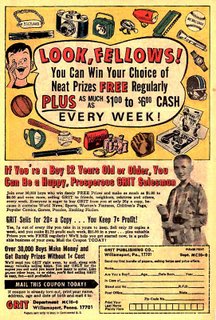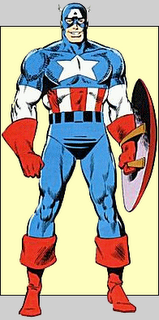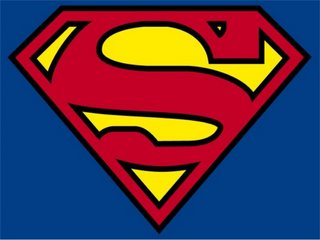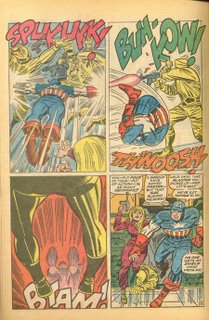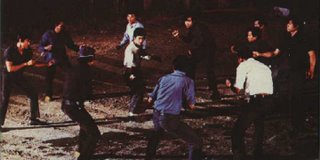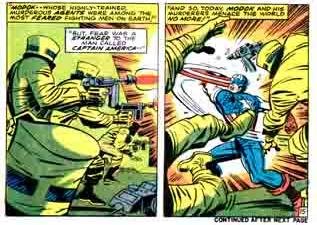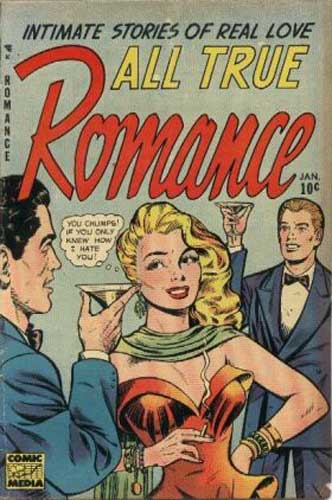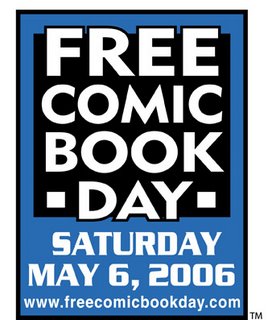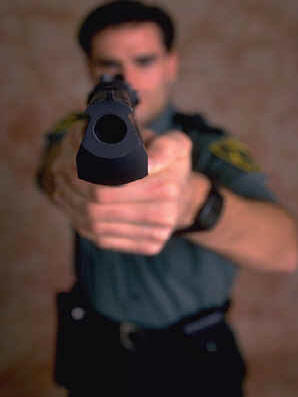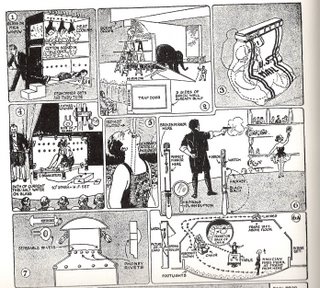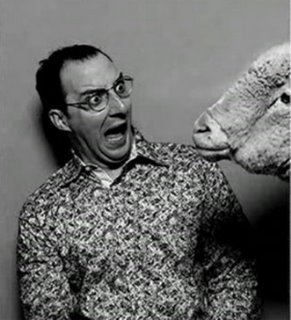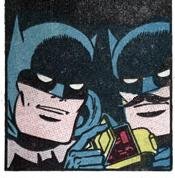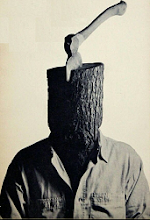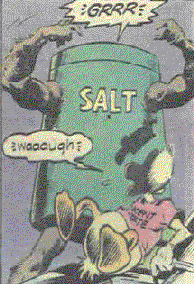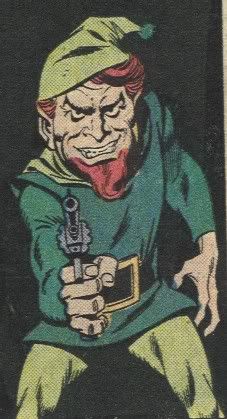The Champions Project: The Reject #1
Page one: A six panel grid, each one showing a television program. We see a group of intellectuals seated in a row of chairs, outside. The host of the program introduces the group: Jean-Pierre Duval, a robotics engineer; François Leclerc, an economist; Sophie Le Mel, a mathematician; and Karkas, a philosopher exiled from the undersea empire of Lemuria. Karkas, a giant red monster, is wearing a striped sweater. He also has a false moustache above his lip, or where a lip would be, if he had one.
 The panel of intellectuals discuss the remarkable breakthrough in robotics being celebrated in Paris today, a joint venture of Ordinateurs de Lyons and a Dutch firm. The “camera” moves to show the Hotel de Ville and, standing in front of it, a handful of strange robots. Dominating the background is a robot Tyrannosaurus Rex. Karkas can still be seen along one side of the panel. Standing next to him is a handsome man in what can only be described as white armor. The man looks bored, like a four-year old who’s had enough of the grownups talking.
The panel of intellectuals discuss the remarkable breakthrough in robotics being celebrated in Paris today, a joint venture of Ordinateurs de Lyons and a Dutch firm. The “camera” moves to show the Hotel de Ville and, standing in front of it, a handful of strange robots. Dominating the background is a robot Tyrannosaurus Rex. Karkas can still be seen along one side of the panel. Standing next to him is a handsome man in what can only be described as white armor. The man looks bored, like a four-year old who’s had enough of the grownups talking.The fifth panel is a blur. The camera swivels. We can’t see anything clearly except for the word balloons showing panic and a sound effect: bzzzzzzz
The sixth and last panel is from the perspective of the ground, as the camera has fallen over. We see a cloud of bees, with a human shape suggested in the center. We also see a white-armored figure charging the bee-man.

Double splash page: A handsome man in white steel armor swings a two-foot long metal rod at a man made entirely of bees! The bee-man, Swarm, gestures dramatically, spewing killer bees in several directions at once! Ordinary people flee, swatting at the stinging clouds of fuzzy, buzzing death!
Caption: “The Place: Paris!”
Caption: “The Villain: a Nazi made of bees!”
Caption: “The Situation: Dire!”
Caption: “Our Only Hope: He Who Haunts the Nightmares of Monsters!”
Caption: “THE REJECT!”
Title: “City of Lights, City of BEES!”
On the next page, we see the Reject collide with Swarm. They both hurtle down into the stairwell of a nearby Metro station. As they fall, the Reject lets out an inhuman roar.
 We then jump to back to street level. Near the Metro entrance, Karkas shepherds the people away from the scene. Meanwhile, we see a trio of masked men dressed in black emerge from the shadows of a nearby building. As Karkas searches for people trapped by the bee-filled madness, he spies the three masked men abducting Dr. Duval. He moves in to stop them.
We then jump to back to street level. Near the Metro entrance, Karkas shepherds the people away from the scene. Meanwhile, we see a trio of masked men dressed in black emerge from the shadows of a nearby building. As Karkas searches for people trapped by the bee-filled madness, he spies the three masked men abducting Dr. Duval. He moves in to stop them.We jump down to the Metro station, where the Reject is faring badly against Swarm. The Reject swings his rod and shrieks. Bees sting the crap out of him. Swarm gloats, in typical Nazi Bee Man fashion, that such tactics are of no use against an army of unstoppable mutant bees.
We jump back to Karkas above-ground. He charges the three masked men, yelling for them to release Dr. Duval. One of the men binds the doctor with handcuffs while the other two point strange-looking firearms at Karkas. As the Deviant reaches the men, they fire their weapons. Two small green canisters fly out from the weapons’ barrels and adhere to Karkas’s red skin. One gloats to the now-collapsing Deviant that the gravitation mines now stuck to the monster’s body will grow in intensity until his body collapses under its own weight.
Karkas, pinned to the ground, watches as an oddly-shaped flying craft appears overhead. It casts down a mauve beam that lifts the three masked men and Dr. Duval off the ground. As they fly away, Karkas curses his inability to help.
We jump again to the Metro. The Reject howls and fires a particle beam from the end of his power rod. The beam cuts through the dead center of Swarm. Swarm couldn’t care less. Dude’s made of bees. In true Nazi Bee Man fashion, he gloats further in his Colonel Klink accent. “Zo, Deviant, your puny mongrel rage ees no match for ze zcience of zee reichhhh!” The Reject falls to one knee, succumbing to the bee sting toxins. Swarm is obnoxious; he’s also right.
Meanwhile, Karkas feels the air pushed out of his lungs. Consciousness flickers in and out. His weight has grown so vast that the sidewalk beneath him cracks and buckles. “Not like this…” he thinks.
Swarm moves in for the kill.
Karkas’s increased weight sends him crashing through the ground and into the Metro station. Directly on top of Swarm.
The Nazi Bee Man’s body scatters under the impact of the Big Red Dude. The skeleton that holds together the Bee Man’s form pulverizes. Swarm is dead. Again.
The Reject looks through badly swollen eyelids to see his only friend in the world, Karkas, being crushed to death. Heedless of his thousands of stings, the Reject aims his power rod and shoots both of the green canisters with a single shot. “Well...well done, my brother,” Karkas wheezes.
We jump to a massive room inside what looks to be a mansion. The room is dark except for the light coming in through a wall of arched windows. In the middle of the room is Jean-Pierre Duval, strapped to a chair. He is gagged. We see fear in his eyes, a not unnatural reaction to being kidnapped by Euro-Ninjas.
For a moment, all is quiet. Then we see his face react with fear as noises emerge. klanklanklankwhrrr. KlankKlankWhrr! KLANKKLANKKLANKWHRRRRR!! What causes this racket, we cannot see. All we can see is a terrified Duval. The sound grows deafening, deforming the panel borders themselves!
Then it stops, and silence returns.
A voice comes in from off-panel. “Bonjour, Jean-Pierre. It’s been a few years, has it not?”
We jump to a hospital, where Karkas explains to the doctors that the Reject can heal himself quickly, a product of his strange heritage and upbringing in the battle arenas of Lemuria, and that attempting to restrain him for treatment would only lead to--
An orderly hurtling through the air completes Karkas’s thought.
The giant Deviant rushes in to find the Reject grappling with two orderlies. A thought bubble appears from the Reject’s head. It shows a cartoon of a doctor’s head being hit by a pipe. Yes, the Reject thinks in images.
Karkas mollifies his enraged “brother” and suggests they leave the hospital. Reporters clog the exit to the hospital, asking questions about the attack, and we see the Reject’s thought balloon in reaction: an image of himself going ape on the reporters.
To defuse the situation, Karkas removes his large fake moustache and sticks it onto the Reject’s lip. The Reject likes the giant moustache and is content to simply walk through the crowd of reporters, beaming with pride at his new facial hair.
We jump to the forensics laboratory of the Paris Police. Two forensic scientists examine the smashed remains of a skeleton. Their dialogue tells us the bones are those of Fritz von Meyer, whom we know as Swarm. They joke a bit, until one pulls out a strange looking gun and shoots his coworker. The shooter then arranges the broken bones of Von Meyer and produces a small vial from his pocket. Inside the vial? A large bee.
We jump again, this time to a large room filled to the brim with techno-gadgets. Many of the gadgets look like standard comic book technology: robots, death rays, and the like. Other bits and pieces are quite bizarre: gelatinous quadripeds, four-dimensional fentoozlers, and the like. Our view of the room moves, as though we were walking down the length of the room. We see nobody, but we hear many voices talking.
The voices describe the joy at acquiring Duval and his successful integration into the project. They dicker back and forth about Swarm. Then one suggests the value of bringing in the Karkas, whose philosophical achievements and knowledge of the Deviants would add a great deal to the project.
The “scene” stops at a large techno-aquarium filled with bubbling fluid and a weird device that looks much like a robot chainsaw. One voice speaks. “Thus we are agreed. Fetch Karkas’s Brain!”
We jump to the robot exhibition outside of the Hotel de Ville. Karkas stares at a robot gorilla and wonders out loud what nefarious plot has led to Duval’s kidnapping, and to what insidious ends the doctor's knowledge will be applied. The Reject says nothing. His thought balloon shows a ham sandwich.
Then the Reject’s eyes fill with amazement.
The robot Tyrannosaurus Rex is moving!
 Robot jaws rush towards Karkas! The Reject shoves his friend out of the way and is captured in the mouth of the beast! Rearing up, the robot T. Rex cannot quite close its jaws. The Reject holds it open!
Robot jaws rush towards Karkas! The Reject shoves his friend out of the way and is captured in the mouth of the beast! Rearing up, the robot T. Rex cannot quite close its jaws. The Reject holds it open!He hears a shrill whine. He swivels his head to see the barrel of a sonic cannon in the back of the beast’s mouth, pointed outward. The cannon’s mouth glows blue.
Meanwhile, Karkas finds himself under assault by Swarm! And a half-dozen Euro-Ninjas! To their displeasure, they find that Karkas’s thick hide is impervious to bee stings and most of the small arms of the Euro-Ninjas. The thugs carry a whole lot of weaponry on their persons, and they use it all. Karkas swats aside a pair of annoying Euro-Ninjas when he hears the cry of the Reject and the whine of the sonic cannon’s buildup.
We jump back to the Reject in the robot’s mouth. His thought balloons pop up. The first shows the cannon firing and destroying him. The second one shows the creature’s mouth firing the cannon without him in the picture. The third shows the creature firing the cannon with its mouth shut, destroying its front teeth. The light bulb goes on!
He stops holding open the robot’s jaws, knowing that they’ll have to stay a little bit open to fire the cannon. Instead, he hurls himself at the cannon! The jaws swing downward but stop before crushing the Reject! He smashes the cannon with his power rod!
Karkas grabs a Euro-Ninja and smashes him against the ground. Swarm curses him and sics thousands of killer bees at the red monster, hoping to find at least one vulnerable spot.
Then the robot tyrannosaurus lets out a mighty shriek! The Reject leaps from the robot’s mouth as strange energies burst forth from the beast! The Reject lands on top of Swarm, howling a battle cry! The robot grinds, shrieks, and stops!
Karkas dispatches the last Euro-Ninja and sees his friend get stung again and again by the Nazi Bee Man, as their struggles move towards the Rue de Rivoli. An idea enters into Karkas’s head. He grabs a canister off of the belt of an unconscious Euro-Ninja and fumbles with it for a moment. He curses his thick claws and misshapen form for not being able to use it himself. He hurls the canister at the Reject and yells for him to pull the ring!
The Reject grabs the canister and, lacking a better idea, does as Karkas suggests. Smoke pours out from the canister.
Exposed to smoke, the bees that make up Swarm’s body immediately become docile. They putter around, ignoring Swarm’s orders to attack.
We see the Reject’s thought balloon: a big yellow smiley face.
Then he brings down his power rod against Swarm’s head, shattering the Nazi’s skull. The bees scatter.
We jump to an apartment. The television set is on, and it dominates the panels. It shows Karkas being interviewed by a reporter about the battle. The Reject, once again wearing the giant false moustache, stands next to his Big Red Buddy, all smiles. Karkas assures the public that everything is fine, and that they will rescue Jean-Pierre Duval.
In the background of the shot, the robot Tyrannosaurus’s mouth-mounted sonic cannon fires and shatters the entrance to the Hotel de Ville. The robot then falls over.
Karkas mutters and holds his head in his hands. The Reject offers Karkas the moustache.
The television set turns off. Our view shifts to the apartment’s sole occupant: an expensively-dressed woman. “No…they’ve begun the Akvan Protocols!”
She reaches for a cigarette, and we see that her left hand is unusual. Though shaped like that of a normal woman, it lacks flesh and blood. Instead, it is a slice of outer space. In her hand, we can see stars, nebulae, and the blackness of the void.
To be continued soon in The Reject #2: Shall Earth Survive?
NOTE: The index to "The Champions Project" can be found here.
Click here to read more!

